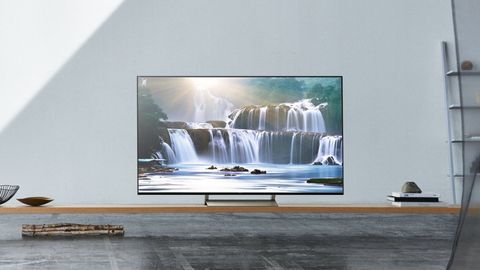TechRadar Verdict
Android TV continues to frustrate, and there’s a backlight clouding price to pay for the TV’s high brightness levels. That said, the 55XE9305 nonetheless improves on Sony’s 2016’s Slim Backlight Drive models in every way, delivering in the process some of the most spectacular pictures ever seen on a TV in 2017.
Pros
- +
Blisteringly bright HDR images
- +
Stunningly rich colours
- +
Much-improved sound quality
- +
Superb HD upscaling
Cons
- -
Blooming around bright objects
- -
Android TV is cumbersome
- -
Runs sluggishly at times
- -
Very limited viewing angle
Why you can trust TechRadar
One of the most ingenious new TV technologies of 2016 was Sony’s Slim Backlight Drive. It put two sets of edge-mounted LEDs and two separate LED light plates in sequence to double the number of individually controllable light zones possible with an edge LED lighting system.
The system is back in improved form on the 2017 XE93 series, increasing the number of individually controlled light zones and introducing a massive boost in brightness to get maximum impact from today’s high dynamic range sources.
The 55XE9305 also builds on its predecessor by including one of Sony’s new X1 Extreme chipsets. These are around 40% more powerful than the original X1 chips, and introduce separate databases to help the TV analyse noise and upscale sub-4K sources to the screen’s native 4K resolution.
Add in an apparently much-improved sound system and Sony’s Triluminos technology for delivering today’s wider colour ranges and, on paper at least, the XE93 series seems to tick all the right boxes.
The XE93 series comes in two different sizes, a £3,200 65-inch and £2,400 55-inch version, the latter of which is what we’ll be covering in-depth here.
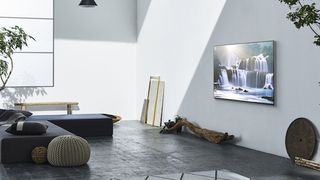
Design
Considering the Slim Backlight Drive was originally designed to be, well, slim, the 55XE9305 is, somewhat ironically, a fairly chunky TV by today’s standards. It’s heavy too – we strongly advise against trying to set it up by yourself.
That said, it does wear its bulk fairly sharply, though. Its black screen frame looks glossy and well built, and the half-and-half gold/black outer trim is distinctive and very ‘Sony’. The gold tone extends to the attractively no-nonsense desktop stand and entire back panel, too.
The back panel is distinctive for two other reasons: the diamond pattern engraved into it, and the fact that large sections of it are made of removable panels. It’s designed that way so that you can hide all your cabling away – Sony enables you to hide cables from external kit within the desktop stand mounts.
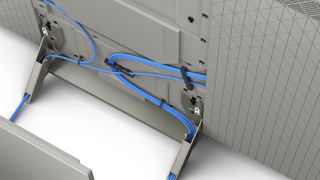
The connections Sony is so keen to hide are as we would expect of a high end 2017 TV: four HDMIs, three USBs for multimedia playback/recording TV to USB drives, and an Ethernet port for adding the TV to your network. You can also network the TV via Wi-Fi, of course.
One last element of the 55XE9305’s design worth mentioning is the remote control. This mercifully dispatches the almost flat buttons that proved so hard to use on 2016’s models, going for a more traditional raised button feel.
There’s still a bit too much going on in the remote’s main, central area for our liking, but at least you now have half a chance of using the remote successfully without looking at down at it every few seconds.
Screen sizes available: 55-inch, 65-inch | Tuner: Freeview HD | 4K: Yes | HDR: Yes (HDR10, Dolby Vision via upcoming firmware update, HLG via upcoming firmware update) | Panel technology: LCD with edge LED lighting, local dimming and Sony’s Slim Backlight Drive technology | Smart TV: Yes, YouView and Android TV | Curved: No | Dimensions: 1232 x 715 x 40mm (W x H x D) | 3D: No | Inputs: Four HDMIs, three USBs, tuner input, Ethernet port, optical digital audio output, analogue audio inputs, headphone output, PCMCIA slot
Design TL;DR: Although it’s too chubby to be totally en vogue, its high build quality, fetching black and gold colour combo and extensive cable-tidying tricks make the 55-inch iteration of the XE93 series a pleasant addition to any room.
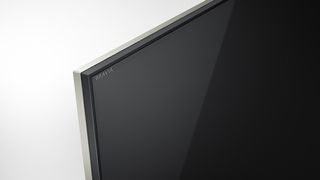
Smart TV (YouView/Android TV)
There are really only two things most people need from a smart TV system: speedy access to favourite content sources, and a crisp, clean, customisable interface. Sadly, the Android TV system on the 55XE9305 delivers neither of these things.
Its interface is cluttered and dictatorial, and provides little to no opportunity for customisation. And Google’s apparent belief that quantity trumps quality where apps are concerned makes it frequently painfully difficult to hunt down favourite apps or specific content.
Google Assistant is due to be added to Sony’s 2017 Android TVs later in the year, and this might improve things a bit, but we can’t help but feel there needs to be a complete rethink of the Android TV approach if it really wants to become a strong smart TV interface.
Sony has at least ensured that the 55XE9305 delivers the 4K and HDR-capable versions of YouTube, Netflix and Amazon, while support for the catch up services of the UK’s ‘big four’ terrestrial services (the BBC, ITV, Channel Four and Channel 5) is provided by the integration of the YouView smart TV system.

Youview helpfully provides an electronic programme guide/listings system that lets you go back seven days (to watch stuff you’ve missed on demand) as well as forward in time to set recordings.
One other issue with the Android TV smart system, though, is that it still seems buggy and sometimes seems to cause the TV’s main menus to run sluggishly.
Smart TV TL;DR: Android TV is less flaky than it used to be and may be improved by the addition of Google Assistant voice recognition later in the year. Overall, though, Android TV still remains our least favourite big brand smart TV interface.
HD/SDR performance
Sony has always been one of the best brands at upscaling HD sources to 4K, but the dual database processing system in the X1 Extreme chipset takes things to a whole new level.
Detail levels are remarkable – good quality HD sources really do transform into something that often looks close to 4K. This transformation, moreover, is achieved with the processing generating scarcely any unwanted side effects. The picture looks clean and natural, a clear testament to the genius of the noise handling part of Sony’s latest upscaling system.
The upscaling effect isn't limited to just adding more texture or pixel density, either. Sony’s upscaling processing is clever enough to calculate the best colour tones for the millions of extra pixels it’s creating with breathtaking accuracy, giving pictures a sense of depth and realism no other upscaling system has delivered before.

On top of that, the 55XE9305 doesn’t just boost the resolution of non-4K images: It also delivers a standard dynamic range to high dynamic range conversion process. Sony is so confident about that you can’t even turn it off with most of the TV’s picture presets. This confidence proves well founded, too, as the system manages to enhance the brightness and colour of standard dynamic range material remarkably effectively. The enriched tones look natural and balanced, as well as enjoying an enhanced sense of ‘volume’ – the word the TV world is now using to describe the effect brightness has on colour.
The extra brightness is introduced by the SDR-to-HDR conversion without leaving bright highlights looking flared out or forced. Also, unlike LG’s recently tested OLED65W7, the screen’s extreme brightness capabilities (it’s capable of hitting peaks of beyond 1500 nits) mean that it can boost an SDR’s image peaks to something at least resembling HDR levels without having to first dim the image’s average brightness.
One last point to add here is that the 55XE9305’s contrast looks mostly superb with SDR content, even when it’s been given the HDR upscale treatment. Black levels are excellent, and signs of backlight clouding/blocking around bright objects are both rare and really faint even when they do show up.
HD/SDR Performance TL;DR: Class-leading upscaling and brilliant colour and light management deliver state of the art HD and SDR quality.
4K/HDR performance
Great though the 55XE9305 looks with HD standard dynamic range sources, this is clearly a TV that’s been built for today’s bleeding edge 4K and HDR content. And for the most part it delivers such cutting edge goodies blisteringly well.
Its extreme brightness – which is up there with what we’ve been led to believe we can expect from Samsung’s upcoming ‘QLED’ Q7 and Q8 models – does a stunning job of expressing the wider brightness range HDR is designed to deliver. In fact, the brightest parts of pictures - street lights, sunlight, metallic reflections, etc... – look far more punchy and intense than they did even on Samsung’s 2016 flagship KS9500 TVs.
Even better, the high brightness performance isn’t restricted to just the most dramatic highlights. The 55XE9305 is able, too, to render high levels of brightness across the whole image when required – such as with all that lovely sun-drenched exterior footage found in the recently released Ultra HD Blu-ray of Planet Earth II. In this respect in particular the 55XE9305 outguns the vast majority of other LCD TVs out there, which usually have to run more dimly when required to cope with a whole screen full of HDR-level brightness.
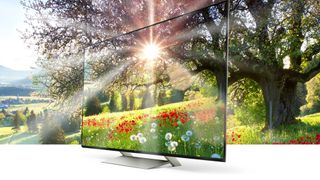
Making all the 55XE9305’s brightness look even more striking is the way the screen is able to resolve subtle shade and colour detail in all but the most extreme bright areas.
This level of tone mapping is still rare in the HDR TV world, with only Samsung previously achieving such subtle tonal information at HDR’s extremes.
The 55XE9305’s brightness helps it do exceptionally well at portraying the colour ‘volume’ aspect of HDR sources, while Sony’s Triluminos technology helps to ensure that again, no matter how vivid and bright an area of colour might be, it still looks gorgeously rich in both saturation and subtle tonal detail.
While HDR perhaps catches the eye most with its brightness, the dark end of the light spectrum is also key to a truly successful HDR picture.
And in some ways the 55XE9305 does extremely well here, too: It’s able to deliver a deeper, richer black than many edge LED solutions, bolstered no doubt by the localised lighting effect of the Slim Backlight Drive and Sony’s Xpanded Dynamic Range technology, which allows power not needed for the dark areas of the picture to be used to boost bright areas.
The 55XE9305 also has the light management prowess to retain good levels of detail in dark corners, rather than just removing so much light from these parts of the picture that they look hollowed out and empty.
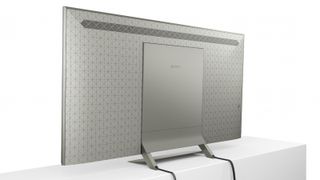
It’s worth adding that all the impressive HDR elements we’ve been talking about so far apply to the relatively unsophisticated HDR10 standard. The 55XE9305 will also be able to handle the likely superior pictures of Dolby Vision HDR content (which uses dynamic metadata to help the TV do a better job of managing HDR content on a scene by scene basis) following a firmware update later in the year.
Resolution holds up better than usual on the 55XE9305, too, when there’s motion in the frame – be it camera pans or objects moving across the screen. Even without applying any of the available motion processing systems there’s a little less judder than you customarily get with LCD TVs. But Sony’s motion processing is also far better than most, causing less artefacts and making movies look less ‘Eastenders-like’ than many rival motion processing systems.
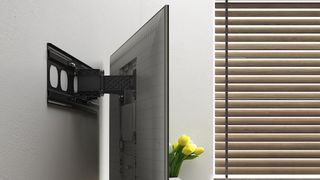
It's a pity is that the absolute most natural-looking motion setting, Clear, also causes the picture to become too dark for comfort - especially with HDR content. That said, picture performance is far from perfect: First, when very bright HDR objects appear against predominantly dark backdrops, you can see unwanted backlight clouding spreading out a good 2-3 inches beyond the bright object’s edges.
The other problem is the TV’s viewing angle. Watch from as little as 25 degrees down the TV’s sides and the backlight ‘blooming’ issue I’ve just described escalates substantially, becoming both more aggressive and more widespread. Colours take a dip in saturation too.
4K/HDR TL;DR: HDR has seldom if ever looked so rich, intense and sharp – though there’s a price to pay for the brightness in the form of some backlight blooming issues, especially if you’re watching from an angle.

Sound
Last year’s KD-XD93 TVs were a disappointment sonically, sounding thin and weedy by Sony’s usually high aural standard. Thankfully things have improved dramatically for the 55XE9305.
The speakers are more powerful and open, and manage to sound more direct. There’s a startling three-dimensional scale to the soundstage too, as it manages to deliver a sense of depth, height and width without losing cohesion or sounding brittle. Importantly, though, despite the scale of the sound, dialogue always stays locked to the screen where it should be.
A bit more bass would be nice but, overall, the 55XE9305’s sound definitely outperforms the majority of other screens in its class – without having to sacrifice its design to do it.
Sound TL;DR: One of the flat TV world’s better sounding TVs – despite its design sporting no discernible speakers.
Other panels to ponder
As one of the first TVs to come our way in 2017, at the time of writing we’re mostly having to consider 2016 TVs for comparison here, with the most obvious alternative being Samsung’s KS9500 (KS9800 in the US). As noted earlier, the 55XE9305 outperforms Samsung’s 2016 flagship TV on colour and brightness. However, the KS9500’s use of a direct LED lighting system, where the lights sit directly behind the screen, means it suffers less often and less aggressively with the backlight clouding distractions you get with Sony’s new set.
Also impossible to ignore are LG’s 2016 OLED TVs - especially the OLED55E6 and OLED55B6. The former of these builds in a decent sound bar alongside its beautifully contrast-rich pictures, while the latter makes OLED technology cheaper than it’s ever been before.
Do bear in mind, though, that these OLED TVs achieve less than half the brightness of the 55XE9305, and so their HDR focus is on the dark end of HDR’s spectrum, not the more eye-catching bright end.
Verdict
Sony has upped its game in every way with the £2,400 55XE9305. Its picture processing is better. Its design is better. Brightness is substantially higher and does a much better job of unlocking the full glory of high dynamic range content than last year’s XD93 series. Colours are delivered with an extraordinary intensity and richness that’s only being witnessed once before: on Sony’s much more expensive ZD9 flagship TVs.
Sharpness levels and detailing are as good as we’ve seen in the 4K era - especially as Sony’s colour processing ensures that colours look as subtly toned as they are vibrant. Even if you’re watching an HD rather than 4K source.
But, that said, even an improved version of Sony’s Slim Backlight Drive can’t completely hide the fact that with current edge LED technology there’s always a backlight-based price to pay for all that HDR-sating brightness.
AV Technology Contributor
John has been writing about home entertainment technology for more than two decades - an especially impressive feat considering he still claims to only be 35 years old (yeah, right). In that time he’s reviewed hundreds if not thousands of TVs, projectors and speakers, and spent frankly far too long sitting by himself in a dark room.

Nikon Z 40mm f/2 review: this cheap, modern 'nifty forty' has been my every day lens for over a year and it hasn't let me down

Could ChatGPT be the next big cybersecurity worry — researchers say it can crack systems faster than ever before

Meta Quest's software is coming to new Asus ROG and Lenovo headsets
